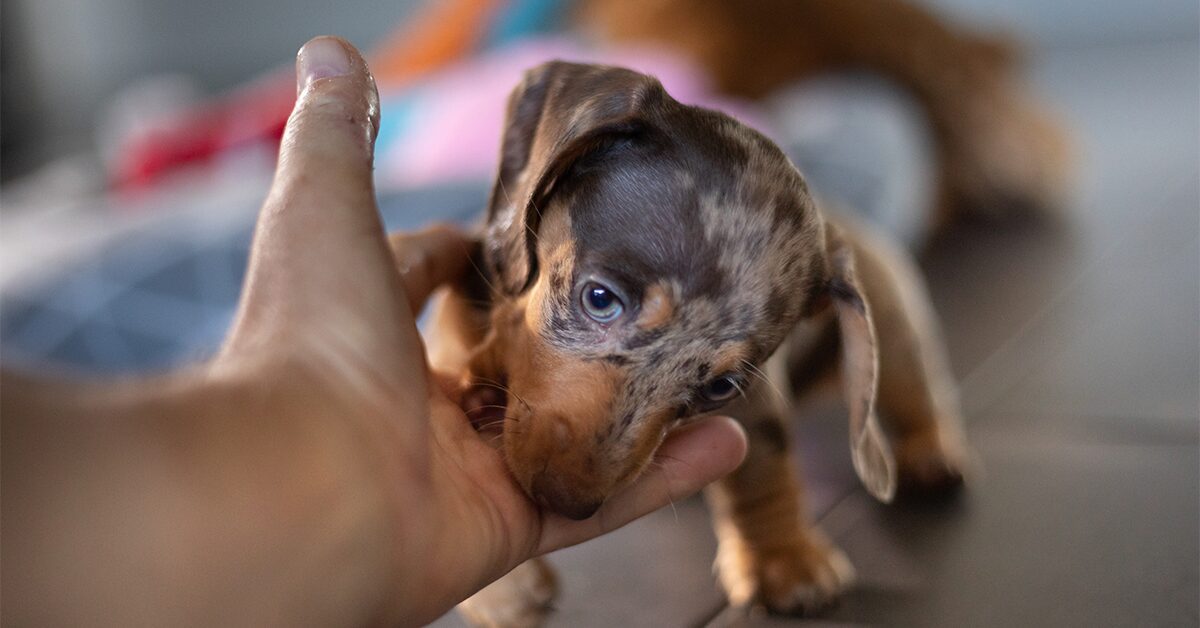Is your puppy nipping or chewing more than usual? Have you noticed a small puddle of drool on your lap after cuddles? It might be a sign of teething. That’s right: your new little furball of joy goes through a teething process, just like human babies. Except, you know, with more sweet puppy breath – and more chew toys.
Puppies, fortunately, get their adult teeth much sooner than humans do. Generally, puppies lose their baby teeth and acquire adult teeth by the time they’re six months of age. As your puppy develops their new teeth, losing their baby (deciduous) teeth in the process, they may experience pain and discomfort.
Read on for a step-by-step guide to puppy teething. Learn all about how to soothe your teething pup – and what you can expect along the way.
8 signs of puppy teething
How do you know if your puppy has started teething? It can be a little tricky to determine this, since the signs of teething aren’t very different from the usual puppy behaviors. But if your puppy is teething, these behaviors will become more frequent and perhaps more intense.
Common signs of puppy teething include:
- Drooling: This is due to sore gums.
- Nipping: Mouthing, gnawing, biting, and nipping are natural instincts for puppies. However, when they’re teething, they might exhibit these behaviors even more frequently.
- Chewing: This relieves pain and gives puppies a chance to use their new teeth.
- Whining: This helps puppies express discomfort.
- Reluctance to eat: if your puppy is slower to start eating – or turns away from their food dish – they may be teething.
- Lost teeth. Don’t be alarmed by this! Your puppy’s lost teeth may be no bigger than a piece of cereal or even a grain of rice. You may notice them after a long chew session or near a pile of dog toys after playtime.
- Swollen gums. Check your puppy’s mouth, and you might be able to see visibly red or sore gums. Even a small amount of bleeding is not unusual. Give your vet a call or a visit if you have any concerns.
- Spots of blood after chewing. A little blood is normal during the teething process for dogs. You’re most likely to see spots of blood on whatever your puppy has been chewing. Don’t worry unless the quantity seems unusual or your puppy is exhibiting visible signs of distress – in which case, don’t hesitate to call your vet.
Puppy teething timeline
The teething stage doesn’t last long, and before you know it, your puppy’s baby teeth are gone and your adult dog has a full set of new chompers.
- 2 to 4 weeks: Baby teeth come in. Puppies are still nursing at this point – their eyes are opening, and they’re beginning to explore the world beyond their mother.
- 5 – 7 weeks: Baby teeth finish growing. Puppies will naturally nip each other and chew everything around them as part of an important stage of their development.
- 12 – 16 weeks: Teething begins as baby teeth fall out. This process can take as long as a few months, though it depends on the individual dog.
Puppies typically have all of their permanent teeth by six months of age. All dog breeds have about 42 adult teeth in total – perfect for a lifetime of ball-catching, stick-chewing, and treat-chomping.
What can I give my puppy for teething pain?
To help your pet during the teething process, offer them gentle chew toys. Dog toys like the KONG offer your puppy the chance to gnaw away without damaging your shoes or your furniture. (Though, let’s face it, your shoes, your couch, and your table legs might suffer during your puppy’s enthusiastic chewing period.)
Which chew toys are best for teething? As mentioned, KONGs are a classic choice for a reason. Fill them with peanut butter for an enticing treat. You can even freeze a stuffed KONG to add to the challenge and increase its gum-soothing effect. KONG now makes a puppy teething stick to alleviate discomfort, as well.
Safe chew toys won’t chip or splinter while your dog noms on them. That’s why rubber toys are a good fit. Nylabones for puppies are a popular choice, and they’re usually available at your local grocery store. You’ll find many ingenious chew toy options online and from specialty pet stores, as well.
Rope toys can be effective, but make sure your dog isn’t shredding them and swallowing bits of rope.
In addition to dog toys, chews like bully sticks can provide relief. Other popular options are naturally shed antlers, which are safer than bones. Never give your puppy any bones that might splinter, as this can lead to choking.
As with many puppy activities, chew time shouldn’t be solo time for your new pet. You don’t have to stare at them the whole time – hey, they’re cute! – but do keep an eye out. Puppies can sometimes hurt themselves with overenthusiastic chewing.
Pet Pro Tip: New kitten owners often underestimate the long-term costs of veterinary care for a pet’s unexpected accidents & illnesses. Make sure you get your kitten insured as soon as possible!
What food and treats can I give my puppy for teething?
You can keep feeding your pup their regular diet. Feeding them treats or special healthy foods is also acceptable during teething.
One difference? You might consider adding soft dog food to your pup’s kibble if you’re not already feeding them any wet food. This will help their kibble go easy on your new puppy’s mouth.
Keep an eye on your new dog. If they yip with pain while eating – or avoid their food – that’s a sign that a change is in order. Always consult with your vet about any dietary changes, of course.
Frozen treats can be a tasty teething snack. Many pet parents swear by ice cubes. Many dogs enjoy chomping away on ice cubes, especially if they’re cubes of frozen chicken broth. Again, as with chews, supervise your pup while they’re enjoying their icy treat.
Doggy dental health
It’s important to pay attention to your dog’s teeth and gums, even beyond the teething phase. That’s because dental health is one of the keys to your pet’s overall wellbeing. You’ll want to take care of your dog’s teeth from the very beginning. Use a doggy toothbrush and a dog-friendly toothpaste to ensure your pup is getting the best dental care when you brush their teeth.
Adult dogs should get a tooth brushing at least once a week – and even daily, if you’re both up for it. Regular dental care prevents periodontal disease and helps give your dog a long, healthy life.
The good news for your pet? Doggy toothpaste comes in pup-friendly flavors like bacon. Yum.
Some dogs enjoy dental chews, too, which can help with stinky breath and overall dental health. (They’re not a substitute for brushing, however.)
The takeaway
Enjoy every moment with your new puppy – they grow up so fast! Teething is just part of the journey to becoming a healthy adult dog. With some extra attention, love, and chew toys, your puppy’s teething will be over before you can say “fetch.”




